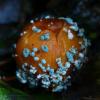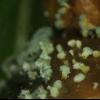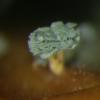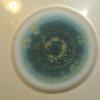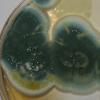
15-12-2025 07:09
 Danny Newman
Danny Newman
indet. Rutstroemiaceae sp. on unk. fallen leavesMc

15-12-2025 21:11
 Hardware Tony
Hardware Tony
Small clavate hairs, negative croziers and IKI bb

15-12-2025 15:54
 Johan Boonefaes
Johan Boonefaes
Unknown anamorph found on the ground in coastal sa

15-12-2025 15:48
 Danny Newman
Danny Newman
Melanospora cf. lagenaria on old, rotting, fallen

15-12-2025 07:05
 Danny Newman
Danny Newman
Pseudosclerococcum golindoi (det: Zotto)near Cosb

15-12-2025 11:49
 Danny Newman
Danny Newman
ITS sequences from the following two collections B

15-12-2025 12:34
 Danny Newman
Danny Newman
indet. Rhytismataceae on oak leafnear Purchase Roa

09-12-2025 12:06
 Andgelo Mombert
Andgelo Mombert
Bonjour,Je recherche l'article concernant Hypobryo
Synnemata of Penicillium/Talaromyces on Hawthorn (Crataegus) fruit
Stephen Martin Mifsud,
08-12-2022 09:10
 Is there a specific Penicllium species like this growing on the rind of decaying fruit (not advanced state of decaying yet) of Crataegus monogyna?
Is there a specific Penicllium species like this growing on the rind of decaying fruit (not advanced state of decaying yet) of Crataegus monogyna?I have not done any microscopical investigations, but perhaps some conclusion can be already drawn from the shape, feeding type and host specificity discussed here. I can do some basic microscopy later on.
I think I managed to have a pure culture (still 1cm wide after 3 days).
Stephen Martin Mifsud,
11-12-2022 08:45

Re : Synnemata of Penicillium/Talaromyces on Hawthorn (Crataegus) fruit
Well, this should be a Talaromyces sp. - but I cant find much knowledge about synnemata species on fruit. Wondering if someone found something similar to compare.... Good Sunday!
Przemyslaw Drzewiecki,
11-12-2022 14:38
Re : Synnemata of Penicillium/Talaromyces on Hawthorn (Crataegus) fruit
Stephen Martin Mifsud,
11-12-2022 21:53

Re : Synnemata of Penicillium/Talaromyces on Hawthorn (Crataegus) fruit
Thank you for this Przemek - seems we have same interest / 'hobby' !!
I am happy to see some of my Penicillium records and colonies match those listed in the document you kindly shared (Is that your work?).
However I think the one I found on Hawthorn is different from those in the doc because it formed distinct tufts (synnemata) while those in the document are species with simple conidiophores. Also, my colonies have yellow-ochre areas - the same colour as the base/column of the synnematous growth.
For now I am happy that I have a pure colony and I will do more research in the coming days.
I am happy to see some of my Penicillium records and colonies match those listed in the document you kindly shared (Is that your work?).
However I think the one I found on Hawthorn is different from those in the doc because it formed distinct tufts (synnemata) while those in the document are species with simple conidiophores. Also, my colonies have yellow-ochre areas - the same colour as the base/column of the synnematous growth.
For now I am happy that I have a pure colony and I will do more research in the coming days.
Przemyslaw Drzewiecki,
11-12-2022 22:31
Re : Synnemata of Penicillium/Talaromyces on Hawthorn (Crataegus) fruit
Yes, mycology is a great hobby. :-) Sorry, I didn't notice that I provided a link without authors.
Here is the public source:
https://www.natur.cuni.cz/biologie/botanika/veda-a-vyzkum/atlas-mikroskopickych-saprotrofnich-hub-ascomycota
Are you sure these fruits didn't pass through the fox's digestive system? It is somewhat similar to Penicillium vulpinum.
Regards, Przemek
Here is the public source:
https://www.natur.cuni.cz/biologie/botanika/veda-a-vyzkum/atlas-mikroskopickych-saprotrofnich-hub-ascomycota
Are you sure these fruits didn't pass through the fox's digestive system? It is somewhat similar to Penicillium vulpinum.
Regards, Przemek
Stephen Martin Mifsud,
12-12-2022 00:57

Re : Synnemata of Penicillium/Talaromyces on Hawthorn (Crataegus) fruit
I'm impressed with that website Przemek, the amount of info is incredible a mix of educative and taxonomic. Even if written in czech, i know I am going to use it.
Your question is very easy to answer. The fungus was found on the skin (epicarp) of the fruit of Crataegus monogyna (Hawthorn) fallen from the tree and lying on moist ground in a valley, still reddish and intact. In our country (Malta) there are no foxes or other mammals that consume this fruit. There were hundreds of fruits and about 10% where infected with this Penicillium.
Your suggestion is valid, it looks likes P. vulpinum (P. claviforme) but it is not copriphilous.
Thanks for messaging!
Your question is very easy to answer. The fungus was found on the skin (epicarp) of the fruit of Crataegus monogyna (Hawthorn) fallen from the tree and lying on moist ground in a valley, still reddish and intact. In our country (Malta) there are no foxes or other mammals that consume this fruit. There were hundreds of fruits and about 10% where infected with this Penicillium.
Your suggestion is valid, it looks likes P. vulpinum (P. claviforme) but it is not copriphilous.
Thanks for messaging!
